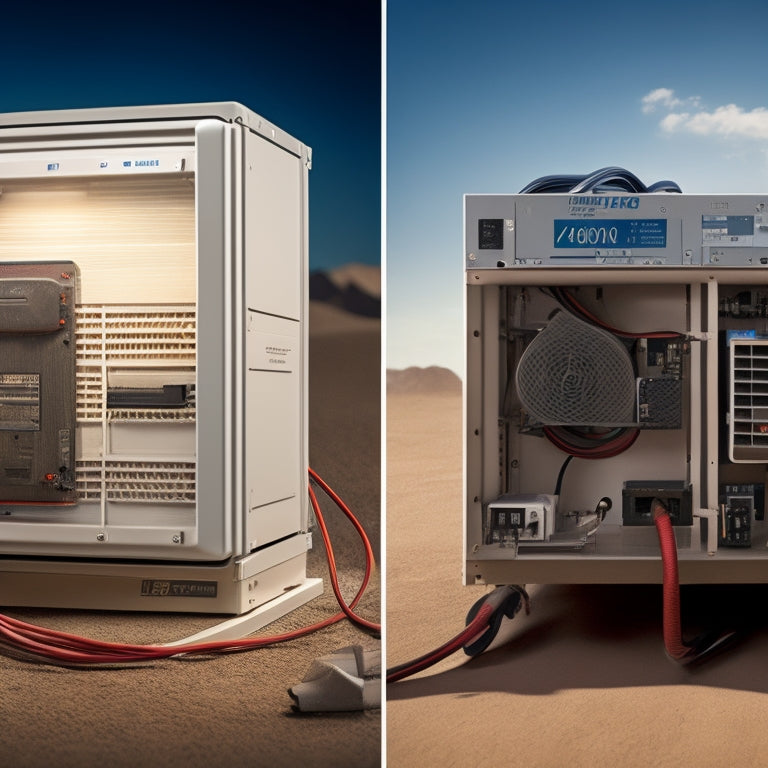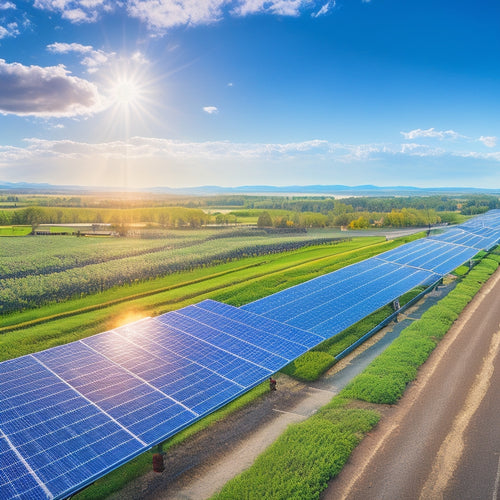
Why Regular Inverter Maintenance Is Crucial
Share
You rely on your solar power system to provide energy efficiency and cost savings, but neglecting regular inverter maintenance can lead to reduced performance, increased energy bills, and even premature component failure. Regular checks and updates guarantee your system operates at peak efficiency, preventing unexpected downtime and enhancing energy production. By staying on top of maintenance, you'll avoid issues like battery problems, overheating, and safety hazards. Now that you know the importance of inverter maintenance, you're likely wondering what steps to take next to safeguard your investment and maximize its potential.
Overview
- Regular inverter maintenance ensures reliability and efficiency of solar power systems, preventing unexpected downtime and enhancing energy production.
- It helps extend the inverter's lifespan by identifying and addressing potential issues before they cause premature component failure.
- Scheduled maintenance tasks, such as inspections and performance checks, can detect minor issues before they escalate into major problems.
- Proper maintenance prevents safety hazards and reduces the risk of energy losses, ensuring optimal system performance and minimizing energy bills.
- Regular maintenance enables performance enhancement through routine updates and checks, ensuring the inverter operates at its peak efficiency.
Importance of Inverter Maintenance
When it comes to guaranteeing the reliability and efficiency of your solar power system, inverter maintenance takes center stage, playing a crucial role in preventing unexpected downtime and enhancing energy production.
A well-maintained inverter guarantees compatibility with solar panels and systems and peak energy conversion, which is essential for maximizing your system's performance.
By prioritizing regular maintenance, you'll extend the inverter's lifespan, assuring inverter longevity and maximizing your system's performance.
Neglecting maintenance can lead to reduced energy output, increased energy bills, and even system failure.
You'll avoid these issues by performing routine checks, cleaning, and firmware updates. This proactive approach enables performance enhancement, allowing your system to operate at its best.
Common Inverter Problems to Avoid
Among the most essential aspects of inverter maintenance is identifying and addressing common issues that can compromise your solar power system's performance.
You need to be aware of potential problems that can lead to system downtime, energy losses, and even safety hazards. Daily energy usage calculation is crucial for accurate solar battery sizing deep cycling capabilities, and incorrect calculations can lead to battery issues.
One common issue you should avoid is battery problems, which can occur due to incorrect charging or discharging patterns, causing reduced battery life and overall system efficiency.
Another essential problem to watch out for is inverter overheating, which can lead to premature component failure and system shutdown.
Scheduled Maintenance Tasks List
To guarantee your solar power system operates at its best, you need a proactive approach to maintenance. This involves creating a scheduled maintenance tasks list to verify your inverter runs smoothly and efficiently.
Begin by scheduling regular inspections every 6-12 months to identify potential issues before they become major problems. It's vital to evaluate grid connection benefits and verify that your system is designed to feed excess energy back into the grid, offsetting energy consumption and providing a stable supply.
Additionally, keep in mind that high-efficiency inverters (above 95%) are significant for minimizing energy losses during the conversion of stored DC power into usable AC electricity.
During these inspections, check for signs of wear and tear, corrosion, or pest infestation. Implement preventive measures such as cleaning the inverter and its surroundings, verifying proper ventilation, and securing all connections.
Additionally, review your inverter's monitoring system to detect any anomalies in its performance. By following this schedule, you'll be able to address minor issues before they escalate, verifying your solar power system continues to generate clean energy and provide you with the freedom you desire.
DIY Inverter Maintenance Tips
How often do you find yourself wondering if you can take matters into your own hands when it comes to inverter maintenance? You can, and it's easier than you think.
Start by cleaning filters regularly to guarantee proper airflow and prevent overheating. Make certain to check connections for signs of wear or corrosion, tightening any loose connections and replacing damaged ones.
Also, inspect the inverter's exterior for dust or dirt buildup, cleaning it off with a soft brush or cloth.
Professional Maintenance Options
Maintaining your inverter at peak performance requires regular tune-ups, and sometimes, it's best to leave it to the professionals. If you're not comfortable with DIY maintenance or need more extensive services, consider hiring a professional. They can provide thorough maintenance contracts, guaranteeing your inverter is always running efficiently.
| Service Type | Frequency | Benefits |
|---|---|---|
| Annual Inspection | Once a year | Identifies potential issues before they become major problems |
| Preventative Maintenance | Quarterly | Reduces downtime and extends inverter lifespan |
| Repair Services | As needed | Fast turnaround and expert repair for minimized downtime |
| Performance Enhancement | Bi-annually | Guarantees peak energy output and reduces energy waste |
| Emergency Response | 24/7 | Rapid response to minimize downtime in case of unexpected issues |
Professional services can provide you with peace of mind, knowing your inverter is in good hands.
Frequently Asked Questions
Can I Use a Non-Original Equipment Manufacturer (Oem) Replacement Part?
When replacing inverter parts, you're tempted to opt for cheaper aftermarket alternatives, but be cautious - they might not meet OEM quality standards, potentially compromising performance and reliability, so it's crucial to weigh cost against potential risks.
How Often Should I Clean My Inverter's Exterior and Interior?
Oh, you think you're a rebel, skipping cleaning schedules, but don't get caught in the dust! You should clean your inverter's exterior monthly, and interior every 3-6 months, adding it to your maintenance checklist to guarantee peak performance.
Are Inverter Maintenance Records Necessary for Warranty Claims?
You'll need to keep accurate inverter maintenance records to guarantee warranty compliance, as manufacturers often require proof of regular maintenance documentation to process claims, so don't risk voiding your warranty by neglecting this vital step.
Can Inverter Maintenance Be Performed During Peak Usage Hours?
As you steer through the power puzzle, you're wise to wonder if maintenance can coincide with peak usage hours; however, you'll find it's best to schedule maintenance during downtime, avoiding peak usage challenges that might hinder efficient timing.
Do I Need to Shut Down the Entire System for Inverter Maintenance?
You shouldn't shut down the entire system for inverter maintenance unless absolutely necessary, as it can cause downtime and revenue loss; instead, follow safety protocols and perform maintenance during planned outages to guarantee system safety and minimize disruptions.
Ready to Buy
"By prioritizing proactive preservation, you'll prevent pesky pitfalls and prolong your inverter's productive life. Regular tuning guarantees your system runs smoothly, silently, and sustainably. Don't let minor mishaps morph into major malfunctions - stay on top of maintenance to maximize your inverter's mighty potential."
Related Posts
-

Building an Emergency Backup Solar Power System in 5 Essential Steps
Building an emergency backup solar power system involves five key steps. First, assess your daily energy needs to ide...
-

Applications of Photovoltaic Systems
Photovoltaic systems are versatile, converting sunlight into electricity for various applications. You can use them i...
-

Top-Rated Home Solar Power Kits for Achieving Energy Independence
Top-rated home solar power kits enable you to achieve energy independence by greatly cutting your energy costs. You c...


